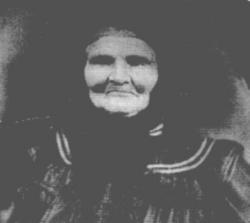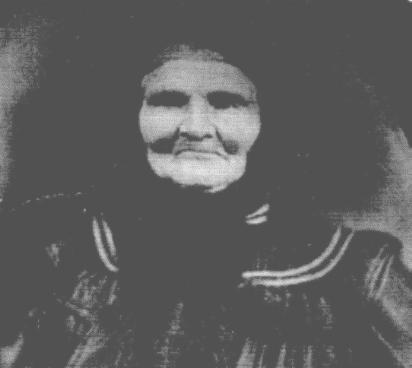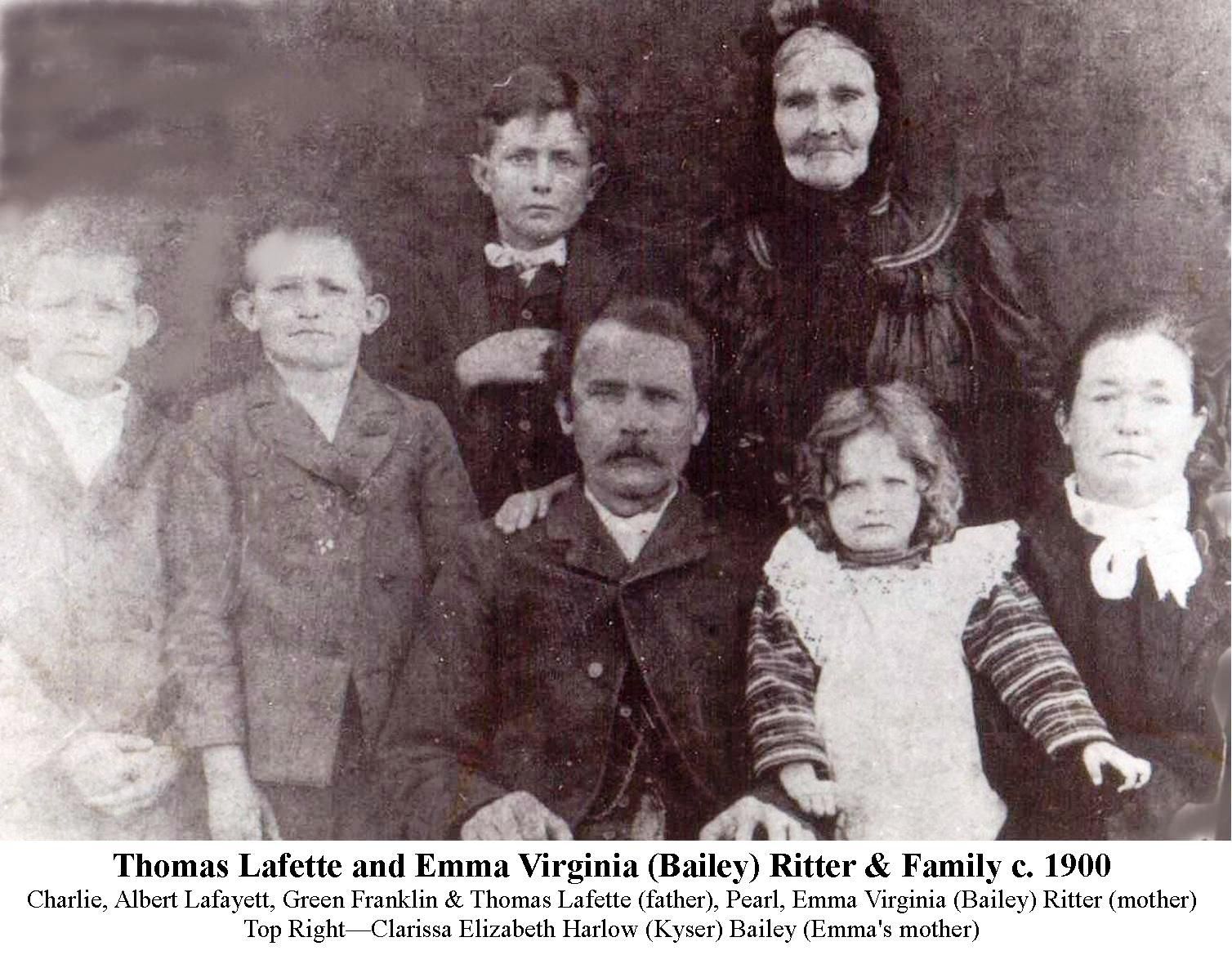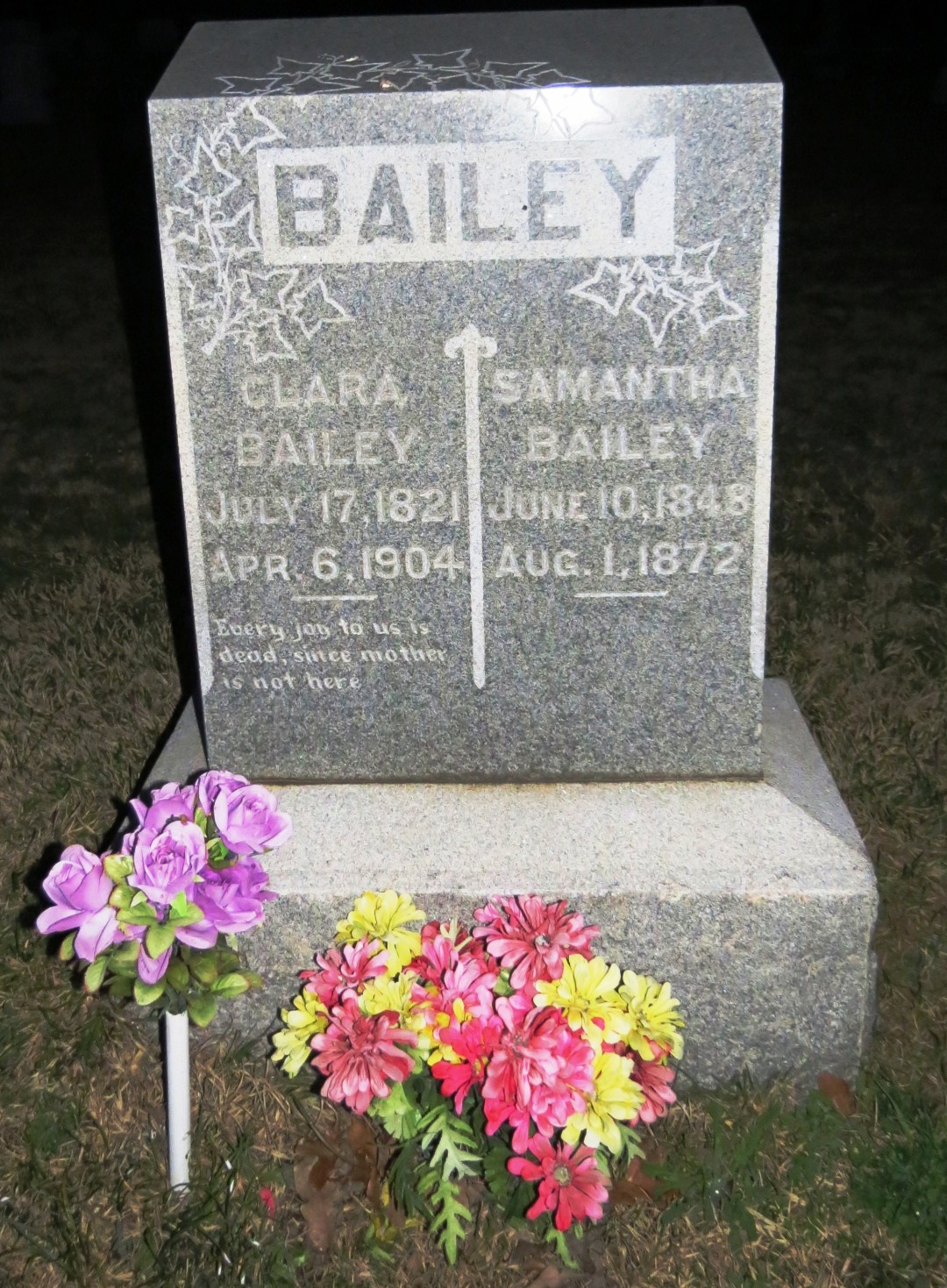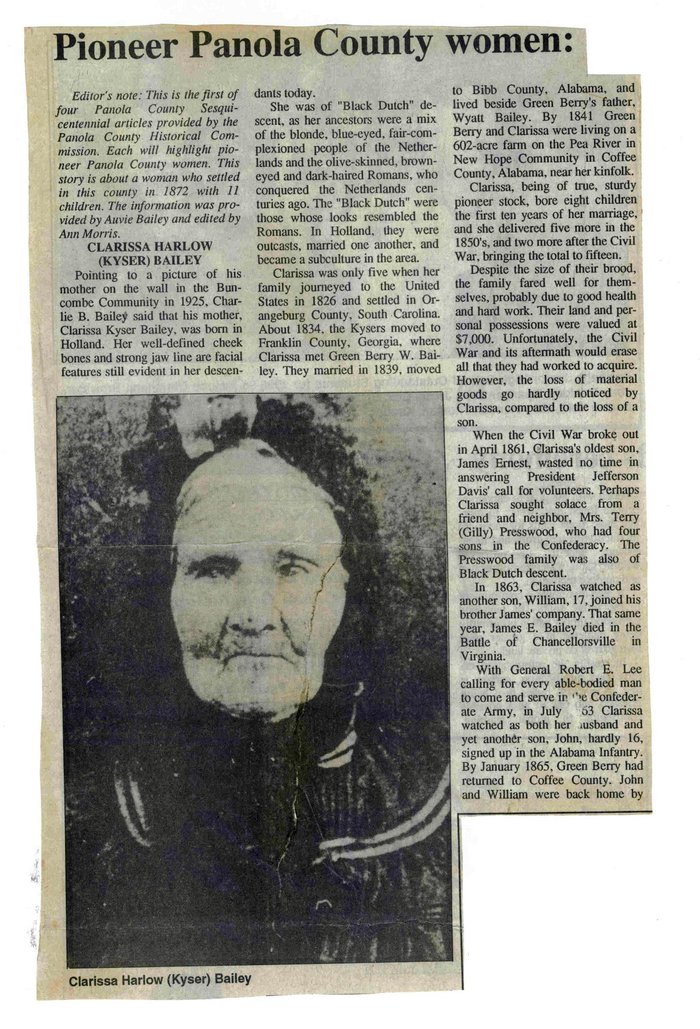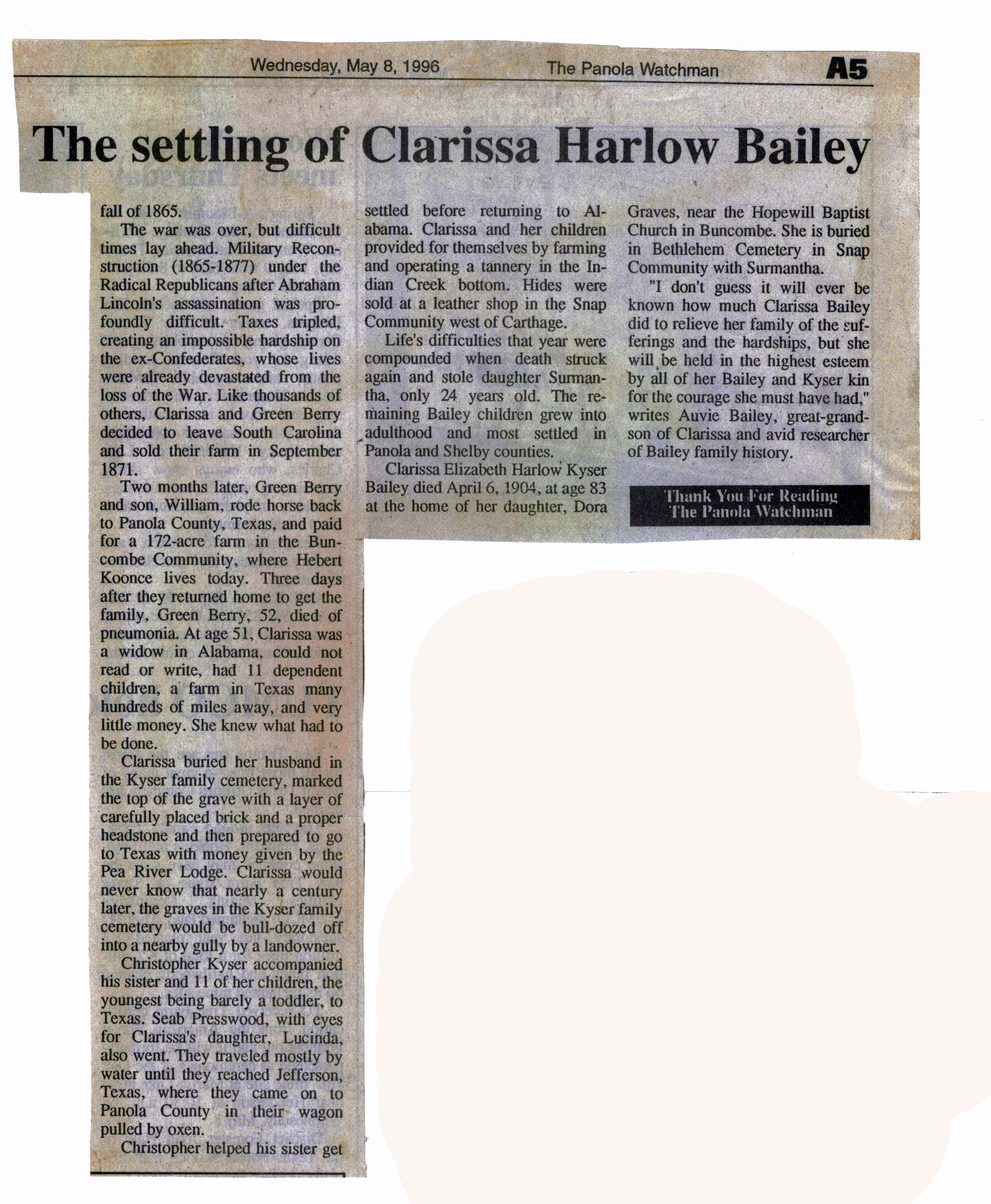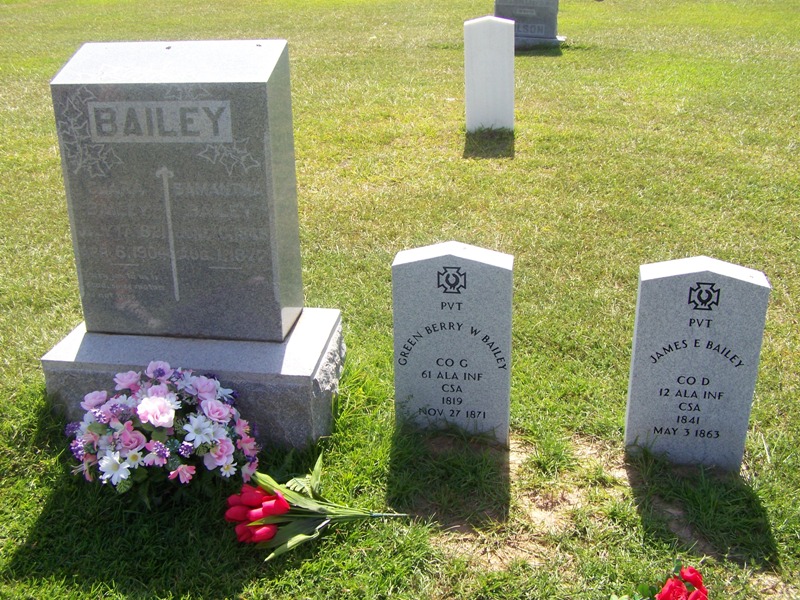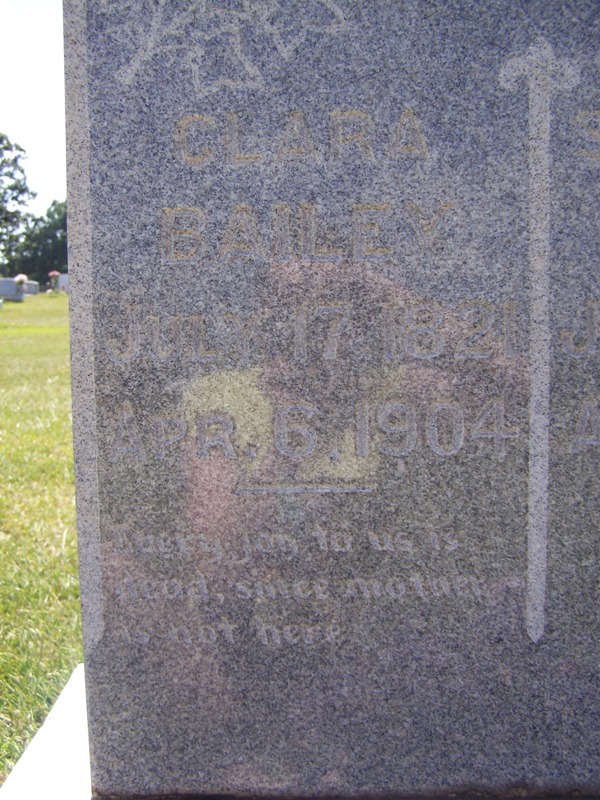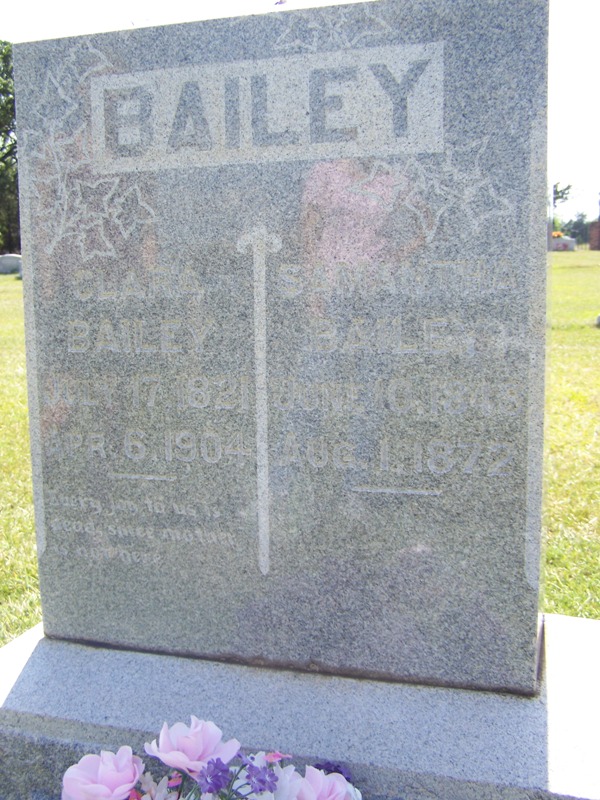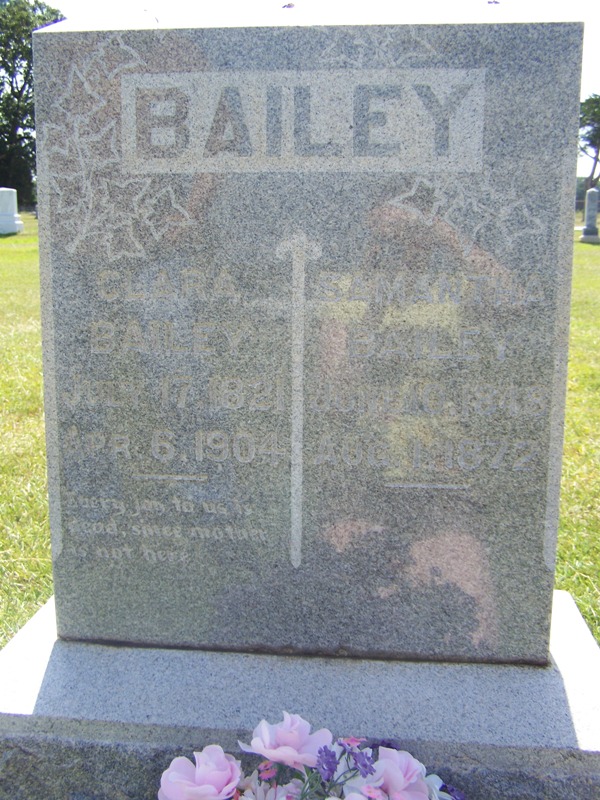Pointing to a picture of his mother on the wall in the Buncombe Community in 1925, Charlie B. Bailey said that his mother, Clarissa Kyser Bailey, was born in Holland*. Her well-defined cheek bones and strong jaw line are facial features still evident in her descendents today. She was of "Black Dutch" descent, as her ancestors were a mix of the blond, blue-eyed, fair-complexioned people of the Netherlands and the olive-skinned, brown-eyed and dark-haired Romans, who conquered the Netherlands centuries ago. The "Black Dutch" were those whose looks resembled the Romans. In Holland, they were outcasts, married one another, and became a subculture in the area.
Clarissa was only five when her family journeyed to the United States in 1826 and settled in Orangeburg County, SC. About 1834, the Kysers moved to Franklin County, GA, where Clarissa met Green Berry W. Bailey. They married in 1839, moved to Bibb County, Alabama, and lived beside Green Berry's father, Wyatt Bailey. By 1841, Green Berry and Clarissa were living on a 602-acre farm on the Pea River in New Hope Community in Coffee County, AL, near her kinfolk.
Clarissa, being of true, study pioneer stock, bore eight children the first ten years of her marriage, and she delivered five more in the 1850's, and two more after the Civil War, bringing the total to fifteen. Despite the size of their brood, the family fared well for themselves, probably due to good health and hard work. Their land and personal possessions were valued at $7,000. Unfortunately, the Civil War and its aftermath would erase all that they had worked to acquire. However, the loss of material goods go hardly noticed by Clarissa, compared to the loss of a son.
When the Civil War broke out in April 1861, Clarissa's oldest son, James Ernest, wasted no time in answering President Jefferson Davis' call for volunteers. Perhaps Clarissa sought solace from a friend and neighbor, Mrs. Terry (Gilly) Presswood, who had four sons in the Confederacy. The Presswood family was also of Black Dutch descent.
In 1863, Clarissa watched as another son, William, 17, joined his brother James' company. That same year, James E. Bailey died in the Battle of Chancellorsville in VA. With General Robert E. Lee calling for every able-bodied man to come and serve in the Confederate Army, in July 1853 Clarissa watched as both her husband and yet another son, John, hardly 16, signed up in the Alabama Infantry. By January 1865, Green Berry had returned to Coffee County. John and William were back home by the Fall of 1865. The war was over, but difficult times lay ahead. Military Reconstruction (1865-1877) under the Radical Republicans after Abraham Lincoln's assassination was profoundly difficult. Taxes tripled, creating an impossible hardship on the ex-Confederates, whose lives were already devastated from the loss of the war. Like thousands of others, Clarissa and Green Berry decided to leave Alabama and sold their farm in September 1871. Two months later, Green Berry and son, William, rode horse back to Panola County, Texas, and paid for a 172-acre farm in the Buncombe Community, where Hebert Koonce lives today. Three days after they returned home to get the family, Green Berry, 52, died of pneumonia. At age 51, Clarissa was a widow in Alabama, could not read or write, had 11 dependent children, a farm in Texas many hundreds of miles away, and very little money. She knew what had to be done.
Clarissa buried her husband in the Kyser family cemetery, marked the top of the grave with a layer of carefully placed brick and a proper headstone, and then prepared to go to Texas with money given by the Pea River Lodge. Clarissa would never know that nearly a century later, the graves in the Kyser family cemetery would be bull-dozed off into a nearby gully by a landowner.
Christopher Kyser accompanied his sister and 11 of her children, the youngest being barely a toddler, to Texas. Seab Presswood, with eyes for Clarissa's daughter, Lucinda, also went.* They traveled mostly by water until they reached Jefferson, Texas, where they came on to Panola County in their wagon pulled by oxen. Christopher helped his sister get settled before returning to Alabama. Clarissa and her children provided for themselves by farming and operating a tannery in the Indian Creek bottom. Hides were sold at a leather shop in the Snap Community west of Carthage.
Life's difficulties that year were compounded when death struck again and stole daughter Surmantha, only 24 years old. The remaining Bailey children grew into adulthood and most settled in Panola and Shelby counties.
Clarissa Elizabeth Harlow Kyser Bailey died April 6, 1904, at age 83 at the home of her daughter, Dora Graves, near the Hopewill Baptist Church in Buncombe. She is buried in Bethlehem Cemetery in Snap Community with Surmantha.
"I don't guess it will ever be known how much Clarissa Bailey did to relieve her family of the sufferings and the hardships, but she will be held in the highest esteem by all of her Bailey and Kyser kin for the courage she must have had," writes Auvie Bailey, great-grandson of Clarissa and avid researcher of Bailey family history.
********************************************************
BUNCOMBE, TEXAS. Buncombe (Bumcomb, Bunkom, Bunkum), off Farm Road 1970 nine miles southwest of Carthage in southwestern Panola County, was probably established after the Civil War. A school known as Alpine opened there around 1884, and a post office operated at the community from 1891 until 1893. In the mid-1930s the small settlement had the school, a church, a cemetery, and a number of houses. After World War II the school was consolidated with that of Clayton, and by the mid-1960s only a church, a cemetery, and a few scattered houses remained in the area.
BIBLIOGRAPHY:
Leila B. LaGrone, ed., History of Panola County (Carthage, Texas: Panola County Historical Commission, 1979). John Barnette Sanders, Index to the Cemeteries of Panola County (Center, Texas, 1964).
********************************************************
*Family Notes:
Even though family stories passed down tell that Clarissa was born in Holland, the U.S. Census records show that she was born in Alabama and her parents born in South Carolina. I believe she was definitely of Dutch descent, however.
I believe the reference to Seab Presswood having eyes for Lucinda is most likely incorrect as Seabon Presswood married Clarissa's daughter Louisa Eliza in January of 1872 in Clayton, Panola County, Texas, shortly after they settled there.
~ Mary Ellen (Fallwell) Henderson ~ Great Granddaughter of Clarissa & Green Berry Bailey.
Pointing to a picture of his mother on the wall in the Buncombe Community in 1925, Charlie B. Bailey said that his mother, Clarissa Kyser Bailey, was born in Holland*. Her well-defined cheek bones and strong jaw line are facial features still evident in her descendents today. She was of "Black Dutch" descent, as her ancestors were a mix of the blond, blue-eyed, fair-complexioned people of the Netherlands and the olive-skinned, brown-eyed and dark-haired Romans, who conquered the Netherlands centuries ago. The "Black Dutch" were those whose looks resembled the Romans. In Holland, they were outcasts, married one another, and became a subculture in the area.
Clarissa was only five when her family journeyed to the United States in 1826 and settled in Orangeburg County, SC. About 1834, the Kysers moved to Franklin County, GA, where Clarissa met Green Berry W. Bailey. They married in 1839, moved to Bibb County, Alabama, and lived beside Green Berry's father, Wyatt Bailey. By 1841, Green Berry and Clarissa were living on a 602-acre farm on the Pea River in New Hope Community in Coffee County, AL, near her kinfolk.
Clarissa, being of true, study pioneer stock, bore eight children the first ten years of her marriage, and she delivered five more in the 1850's, and two more after the Civil War, bringing the total to fifteen. Despite the size of their brood, the family fared well for themselves, probably due to good health and hard work. Their land and personal possessions were valued at $7,000. Unfortunately, the Civil War and its aftermath would erase all that they had worked to acquire. However, the loss of material goods go hardly noticed by Clarissa, compared to the loss of a son.
When the Civil War broke out in April 1861, Clarissa's oldest son, James Ernest, wasted no time in answering President Jefferson Davis' call for volunteers. Perhaps Clarissa sought solace from a friend and neighbor, Mrs. Terry (Gilly) Presswood, who had four sons in the Confederacy. The Presswood family was also of Black Dutch descent.
In 1863, Clarissa watched as another son, William, 17, joined his brother James' company. That same year, James E. Bailey died in the Battle of Chancellorsville in VA. With General Robert E. Lee calling for every able-bodied man to come and serve in the Confederate Army, in July 1853 Clarissa watched as both her husband and yet another son, John, hardly 16, signed up in the Alabama Infantry. By January 1865, Green Berry had returned to Coffee County. John and William were back home by the Fall of 1865. The war was over, but difficult times lay ahead. Military Reconstruction (1865-1877) under the Radical Republicans after Abraham Lincoln's assassination was profoundly difficult. Taxes tripled, creating an impossible hardship on the ex-Confederates, whose lives were already devastated from the loss of the war. Like thousands of others, Clarissa and Green Berry decided to leave Alabama and sold their farm in September 1871. Two months later, Green Berry and son, William, rode horse back to Panola County, Texas, and paid for a 172-acre farm in the Buncombe Community, where Hebert Koonce lives today. Three days after they returned home to get the family, Green Berry, 52, died of pneumonia. At age 51, Clarissa was a widow in Alabama, could not read or write, had 11 dependent children, a farm in Texas many hundreds of miles away, and very little money. She knew what had to be done.
Clarissa buried her husband in the Kyser family cemetery, marked the top of the grave with a layer of carefully placed brick and a proper headstone, and then prepared to go to Texas with money given by the Pea River Lodge. Clarissa would never know that nearly a century later, the graves in the Kyser family cemetery would be bull-dozed off into a nearby gully by a landowner.
Christopher Kyser accompanied his sister and 11 of her children, the youngest being barely a toddler, to Texas. Seab Presswood, with eyes for Clarissa's daughter, Lucinda, also went.* They traveled mostly by water until they reached Jefferson, Texas, where they came on to Panola County in their wagon pulled by oxen. Christopher helped his sister get settled before returning to Alabama. Clarissa and her children provided for themselves by farming and operating a tannery in the Indian Creek bottom. Hides were sold at a leather shop in the Snap Community west of Carthage.
Life's difficulties that year were compounded when death struck again and stole daughter Surmantha, only 24 years old. The remaining Bailey children grew into adulthood and most settled in Panola and Shelby counties.
Clarissa Elizabeth Harlow Kyser Bailey died April 6, 1904, at age 83 at the home of her daughter, Dora Graves, near the Hopewill Baptist Church in Buncombe. She is buried in Bethlehem Cemetery in Snap Community with Surmantha.
"I don't guess it will ever be known how much Clarissa Bailey did to relieve her family of the sufferings and the hardships, but she will be held in the highest esteem by all of her Bailey and Kyser kin for the courage she must have had," writes Auvie Bailey, great-grandson of Clarissa and avid researcher of Bailey family history.
********************************************************
BUNCOMBE, TEXAS. Buncombe (Bumcomb, Bunkom, Bunkum), off Farm Road 1970 nine miles southwest of Carthage in southwestern Panola County, was probably established after the Civil War. A school known as Alpine opened there around 1884, and a post office operated at the community from 1891 until 1893. In the mid-1930s the small settlement had the school, a church, a cemetery, and a number of houses. After World War II the school was consolidated with that of Clayton, and by the mid-1960s only a church, a cemetery, and a few scattered houses remained in the area.
BIBLIOGRAPHY:
Leila B. LaGrone, ed., History of Panola County (Carthage, Texas: Panola County Historical Commission, 1979). John Barnette Sanders, Index to the Cemeteries of Panola County (Center, Texas, 1964).
********************************************************
*Family Notes:
Even though family stories passed down tell that Clarissa was born in Holland, the U.S. Census records show that she was born in Alabama and her parents born in South Carolina. I believe she was definitely of Dutch descent, however.
I believe the reference to Seab Presswood having eyes for Lucinda is most likely incorrect as Seabon Presswood married Clarissa's daughter Louisa Eliza in January of 1872 in Clayton, Panola County, Texas, shortly after they settled there.
~ Mary Ellen (Fallwell) Henderson ~ Great Granddaughter of Clarissa & Green Berry Bailey.
Inscription
"Every joy to us is dead,
since mother is not here."
Family Members
-
![]()
James Ernest Bailey
1841–1863
-
![]()
Nancy C. "Sis" Bailey Wall
1843–1933
-
W C Bailey
1845–1850
-
![]()
Williams M "General" Bailey
1845–1913
-
![]()
John Wilburn "Baker" Bailey
1846–1922
-
![]()
Samantha Bailey
1848–1872
-
![]()
Martha Lucinda Bailey Lindsey
1850–1909
-
![]()
Louisa Eliza Bailey Presswood
1853–1915
-
![]()
Mary Adeline "Pompi" Bailey Satterwhite
1854–1947
-
![]()
Green Berry Bailey Jr
1855–1923
-
![]()
Dora Clara Bailey Graves
1856–1925
-
![]()
Charles Buckner "Charlie" Bailey
1860–1927
-
![]()
William Francis "Barto" Bailey
1861–1947
-
![]()
Donnie Ella Bailey Fallwell
1863–1939
-
![]()
Emma Virginia "Mae" Bailey Ritter
1871–1924
